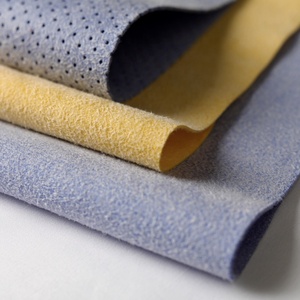Popular in your industry




































































Top categories
About microfiber detergent
Understanding the unique cleaning needs of microfiber materials is essential for maintaining their effectiveness and longevity. A microfiber detergent is specially formulated to clean and preserve the intricate fibers without causing damage or reducing their absorbency. This type of detergent is crucial for businesses that rely on microfiber materials for cleaning, detailing, or any application where the integrity of the microfiber is paramount.
Types of Microfiber Detergent and Their Characteristics
Within the realm of microfiber detergents, there are several types to consider, each with unique characteristics. For instance, microfiber wash detergent is often concentrated for heavy-duty cleaning, while microfiber towel detergent may be gentler, designed for delicate tasks. Products like p&s rags to riches are known for their ability to restore microfiber towels to their original condition, whereas microrestore focuses on deep cleaning without leaving residues. Understanding the specific needs of your microfiber materials will guide you to the appropriate type of detergent, whether it's for robust cleaning or gentle, frequent washes.
Structure and Operation of Microfiber Detergent
The physical components of a microfiber detergent are meticulously engineered to ensure optimal performance. The structure of these detergents includes surfactants that work to release dirt and absorbency agents that maintain the microfiber's ability to soak up liquids. The operation of these components in unison allows for a deep clean that reaches the microfiber's core without damaging the fibers. This careful balance ensures that the microfiber materials continue to perform as expected, wash after wash.
Materials in Microfiber Detergent and Their Properties
The materials used in microfiber detergents are selected for their cleaning efficacy and fabric compatibility. Surfactants are chosen for their ability to break down oils and grease, while solvents are included to dissolve stubborn stains. These materials are often biodegradable, reflecting an eco-friendly approach. The absence of harsh chemicals like bleach and fabric softeners is intentional, to prevent damage to the microfibers and to ensure the safety of the user and the environment.
Business Usages and Applications of Microfiber Detergent
Microfiber detergents are indispensable in various business settings. In the hospitality industry, they ensure that cleaning cloths and mops are effective and durable. Automotive businesses use specialized detergents like rags to riches p&s to maintain the quality of their detailing towels. In healthcare, where sanitation is paramount, these detergents help in effectively cleaning microfiber products used to control contamination. The use of these detergents in businesses not only maintains cleanliness but also contributes to cost savings by prolonging the life of microfiber products.
Functions of Microfiber Detergent
The primary function of a microfiber detergent is to clean and maintain the integrity of microfiber fabrics. These detergents are designed to remove dirt, oils, and bacteria without leaving behind residues that can degrade the fabric's effectiveness. They are also formulated to preserve the electrostatic properties of microfiber, which are essential for trapping dust and particles.
Features of Microfiber Detergent
Microfiber detergents boast features that set them apart from conventional detergents. They often have a neutral pH, are rinse-free, and leave no scent or optical brighteners. This ensures that microfiber products do not lose their texture or color after washing. The detergents are also designed to work at different temperatures, allowing for energy savings and adaptability in various washing conditions.
Benefits of Microfiber Detergent
Using a microfiber detergent offers numerous benefits. It extends the life of microfiber materials, preserves their cleaning efficiency, and ensures that they remain hypoallergenic. For businesses, this translates to reduced replacement costs and a consistent level of cleanliness. Additionally, the eco-friendly nature of these detergents aligns with green business practices, enhancing a company's environmental responsibility.
How to Use Microfiber Detergent Effectively
To use microfiber detergent effectively, it is important to follow the manufacturer's instructions regarding dosage and water temperature. It is also advisable to wash microfiber materials separately to prevent lint transfer and to use a gentle washing cycle. Avoiding the use of fabric softeners and bleach will also ensure that the microfibers retain their cleaning properties.
How to Choose the Right Microfiber Detergent
Choosing the right microfiber detergent involves considering the type of microfiber material you are cleaning and the level of soiling. For heavily soiled items, a stronger detergent like good stuff microfiber wash may be necessary. For more delicate items, a gentler formula would be appropriate. It is also important to consider the environmental impact of the detergent and to select a product that aligns with your business's sustainability goals.
How to Clean and Maintain Microfiber with Detergent
Cleaning and maintaining microfiber with microfiber detergent requires a careful approach. After washing, microfiber materials should be air-dried or tumble dried on a low setting to prevent shrinkage and maintain their absorbency. Regular cleaning with the appropriate detergent will ensure that microfiber materials remain effective for cleaning and detailing tasks.
Target Audience for Microfiber Detergent
The target audience for microfiber detergents includes a wide range of businesses and industries. From automotive detailing shops to healthcare facilities, any setting that relies on microfiber materials for cleaning and maintenance can benefit from these specialized detergents. By meeting the specific cleaning needs of these diverse audiences, microfiber detergents play a crucial role in maintaining high standards of cleanliness and efficiency.
What are the best practices for using microfiber detergent in commercial settings?
In commercial settings, the best practices for using microfiber detergent include following the manufacturer's dosage recommendations, segregating microfiber materials from other laundry, and implementing a regular washing schedule to prevent the buildup of grime. Additionally, training staff on the proper handling and care of microfiber materials can significantly extend their lifespan and effectiveness.
Can microfiber detergent be used for other types of laundry?
While microfiber detergent is specifically designed for microfiber materials, it is generally safe for other types of laundry. However, its specialized formula means it may not be as effective on other fabrics that require different cleaning agents to address specific stains or odors. It's always best to use a detergent that matches the cleaning needs of the fabric in question.
Is microfiber detergent environmentally friendly?
Many microfiber detergents are formulated with eco-friendliness in mind. They often omit phosphates, bleach, and fabric softeners, which are harmful to the environment. By choosing a microfiber wash detergent that is labeled as eco-friendly, businesses can ensure that they are not only taking care of their cleaning tools but also minimizing their ecological footprint.





















